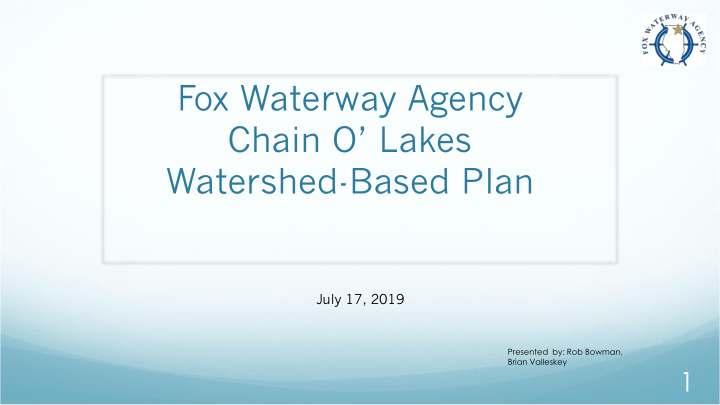



Fox Waterway Agency Chain O’ Lakes Watershed-Based Plan July 17, 2019 Presented by: Rob Bowman, Brian Valleskey 1
Agenda Introductions Objective Definition, Description & Benefits Stakeholders Project Examples Next Steps 2
Introduction Speakers Joe Keller Executive Director Rob Bowman Superintendent Contributors Brian Vallesky Manhard Consultant Randy Sweet Chairman FWA Advisory Committee Pat Smarto FWA Advisory Committee 3
Why are we here? We are all here today as stewards of the waterway. In that light we need to to create a plan for the improvement and long term preservation of the water bodies ( Lakes, rivers, creeks, etc). The livelihood of businesses and continued economic growth is dependent on this waterway resource, e.g. property values, tax revenues, etc That plan does not exist today. More can be done as partners than any one of us individually 4
To be accomplished… Establish a Watershed Based Plan approved by the EPA to facilitate access to 319 funding and bring communities & entities together for a common goal of water quality and water management best practices. 5
9 Elements for Watershed Based Plans EPA Nonpoint Source (Section 319) Program Identify cause and sources of pollution Estimate pollutant loading into the watershed and the expected load reductions Describe management measures that will achieve load reductions and target critical areas Estimate amounts of technical and financial assistance and the relevant authorities needed to implement the plan Develop an information/education component Develop a project schedule Describe the interim measurable milestones Identify indicators to measure progress Develop a monitoring component 6
What is Watershed Planning? Watershed planning and management comprise an approach: to protecting water quality for the whole watershed • manage polluted runoff • pollution is caused by a variety of land use activities including development, transportation, • and agriculture Watershed planning and management involves a number of activities including: • targeting priority problems in the watershed; • promoting a high level of involvement by interested and affected parties; • developing solutions to problems through the use of the expertise and authority of multiple agencies and organizations; • measuring success through monitoring
Major Benefits Improves water quality through project implementation Opens door to additional funding mechanisms Comprehensive plan to effectively prevent/limit the sediment and material loading from reaching our system thus reducing dredging needs Mechanism to help further promote proactive stewardship vs. reactive through sound science instead of crisis management Identify stakeholders and work as a cohesive unit towards common goal Provide forum for betterment of the system while prioritizing appropriate projects Educate the public and promote community involvement 8
What a watershed based plan does . Identifies stakeholder projects for 319 grant funding (FWA implemented and other) Identifies projects for prioritization and the subsequent implementation to address impairments Helps to identify sources of water pollution Roadmap to sustainable maintenance of the waterway and done in a way to improve water quality 9
Geographical Scope Northern boundary: Wisconsin state line HUCs (Hydrologic Unit Codes) Channel Lake Bassett Creek-Fox River Nippersink Lake-Fox River Pistakee Lake Fox River 10
Existing Adjoining Watershed Plans 11
Stakeholders Townships (7) County (6) Federal (3) Lake Villa Lake County USCG (Stormwater, Public Wauconda USDA works, etc) Grant Army Corp of Eng. Lake County Forest Antioch Preserve Burton Businesses Lake County Preservation McHenry Township 25 HOAs (Home Owners Foundation Nunda Associations) McHenry County 12 Marinas (Stormwater, Public Municipalities (8) works, Conservation, etc) 17 Restaurants/Bars McHenry Lake County DOT Ancillary businesses Ingleside McHenry DOT Lake Villa Lake Associations Fox Lake State (4) Friends of Lake Catherine Volo IEPA Lakemoor Recreational Users IDOT Johnsburg ~ 23,000 Sticker holders IDNR Antioch IL Historical Preservation 12 Assoc
Project example Tower Lakes (slide from recent ILMA Conference) 13
What makes for a good project? Restoration based activities: Stream restoration, stabilization, enhancement & protection Shoreline restoration, stabilization, enhancement & protection Wetland restoration, stabilization, enhancement & protection Stormwater pond retrofits and restoration Landscape based water quality protection measures such as rain gardens, bioswales, native vegetation enhancement, bioretention Runoff based protections and initiatives 14
Next step(s) Acquire financial commitments from stakeholders to actively participate and fund the match requirements of the Section 319 grant. Apply for Section 319 grant Continue to gather support from additional stakeholders Coordinate approval of the Grant with the IEPA Begin the planning process to take advantage of NEW funding for projects 15
Closing Thoughts Basis for true long term effective and notable stewardship of the waterway “Think of not the way it is now, but rather than what it could be. A foundation and structure to build on together” 16
End 17
Addendum 18
9 Lakes Watershed Plan (Example) 200 projects identified by stakeholders and leadership team during planning process, many lake-centric.
Recommend
More recommend